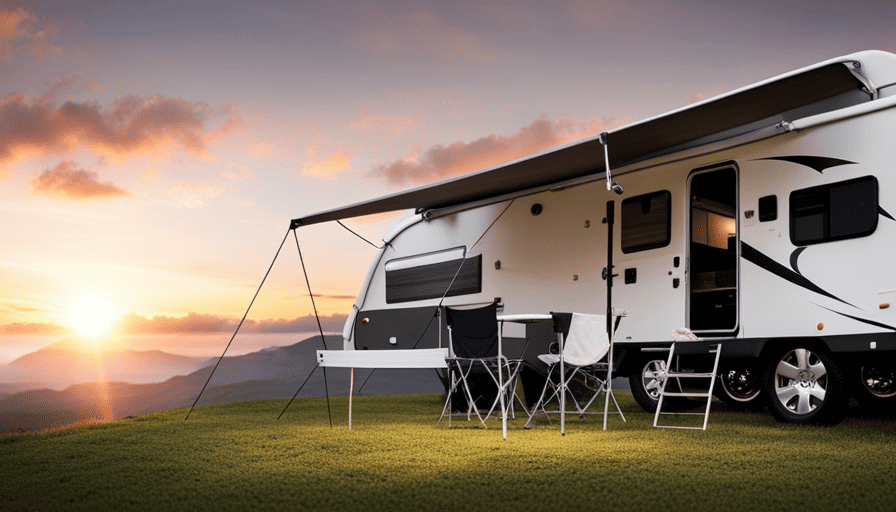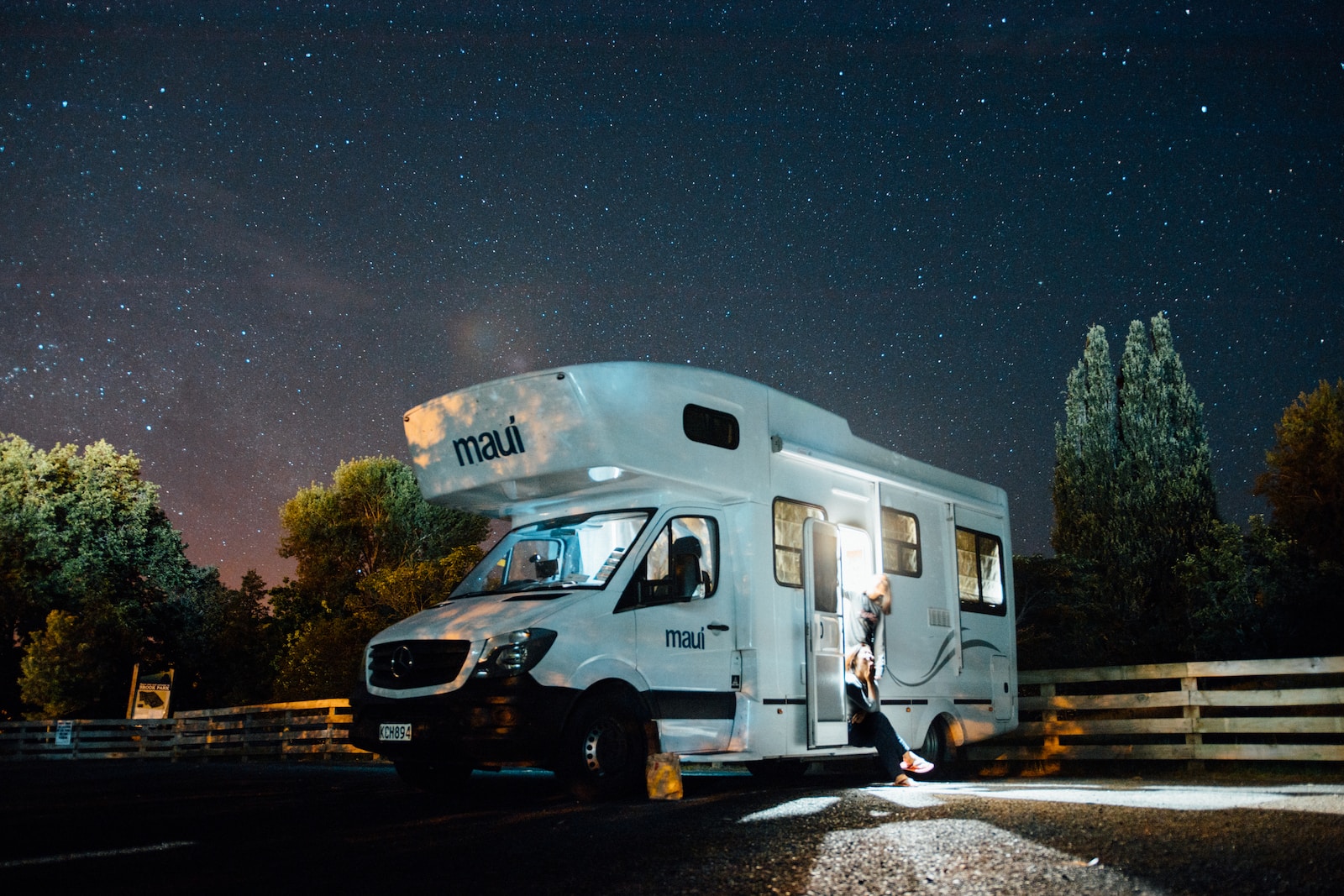Did you know that almost half of campers in the United States are used year-round, even during the winter? If you’re one of those adventurous people who enjoy camping in the colder months, then you understand the importance of having a well-insulated camper. As an experienced camper myself, I understand the need to stay warm and cozy when the temperature drops.
That’s why I’m here to share my knowledge on how to insulate your camper for winter use. In this article, I will guide you through the process of:
- Assessing your camper’s current insulation
- Sealing drafts and leaks
- Installing insulation in the walls and ceiling
- Insulating windows and doors
- Using reflective insulation on the floor
- Upgrading your heating system
- Using insulated curtains or blinds
- Insulating plumbing and water tanks
- Preparing for condensation and moisture control.
By following these steps, you’ll be able to enjoy the beauty of nature even in the harshest winter conditions. So, let’s get started and make your camper winter-ready!
Key Takeaways
- Assess current insulation and seal drafts and leaks
- Install insulation in walls, ceiling, windows, and doors
- Upgrade the heating system for better energy efficiency
- Insulate plumbing and water tanks to prevent freezing
Assess Your Camper’s Current Insulation
Take a moment to really feel the bone-chilling cold seeping through the thin walls of your camper, as you assess its current insulation. Assessing the effectiveness of your camper’s insulation is crucial before diving into any winterization efforts.
Start by examining the walls, ceiling, and floor for any signs of insulation weak points. Look for areas where the insulation may be thin or damaged, such as gaps around windows, doors, or vents. These weak points are the primary culprits for letting cold air sneak in and warm air escape.
Next, check the condition of your camper’s windows and doors. Inspect the weather stripping and seals for any signs of wear or damage. Even small gaps can significantly impact the overall insulation performance. Don’t forget to also assess the condition of any skylights, vents, or hatches as they can be potential sources of heat loss.
Once you have identified the insulation weak points, you can move on to the next step of winterizing your camper: sealing any drafts or leaks. By addressing these issues, you will create a more comfortable and energy-efficient living space, keeping the cold air out and the warm air in.
Seal Any Drafts or Leaks
To effectively prepare your camper for colder temperatures, it’s crucial to identify and seal any drafts or leaks. A well-insulated camper will help keep you warm and comfortable during the winter months.
One of the first steps in achieving this is to focus on air sealing. Look for any areas where cold air might be entering the camper, such as around windows, doors, and vents. Use weatherstripping to seal these gaps and prevent drafts. This can be as simple as applying adhesive-backed foam tape or using silicone caulk to fill small cracks.
Pay close attention to the seams and joints in your camper’s exterior. These areas are common culprits for air leakage. Consider using a high-quality sealant or expanding foam to seal these gaps.
Additionally, check for any holes or gaps in the camper’s floor, as cold air can easily seep in through these openings. Use a combination of insulation and sealant to effectively close off these potential entry points.
By sealing drafts and leaks in your camper, you’ll create a more airtight and energy-efficient space. This will make it easier to maintain a comfortable temperature inside, even in the coldest weather.
Once you have completed this step, you can move on to the next section: installing insulation in the walls and ceiling.
Install Insulation in the Walls and Ceiling
Once you’ve tackled the task of sealing drafts and leaks, it’s time to enhance the coziness of your mobile home by adding a layer of warmth to the walls and ceiling.
To achieve this, you need to install insulation in these areas. There are various types of insulation materials available for campers, each with its own benefits and drawbacks.
Firstly, fiberglass insulation is a popular choice due to its affordability and effectiveness in trapping heat. It comes in rolls or batts that can be easily cut to fit the desired space.
Secondly, foam board insulation is a great option for its durability and excellent thermal resistance. It can be glued or screwed onto the walls and ceiling, providing a solid barrier against the cold.
Lastly, reflective insulation, such as radiant barriers or foil-faced insulation, can be used to reflect heat back into the camper, making it more energy-efficient.
When considering insulation options, it’s important to also keep the cost in mind. Fiberglass insulation tends to be the most cost-effective, while foam board insulation may require a higher initial investment. Reflective insulation falls somewhere in between.
Next, we will discuss how to insulate the windows and doors, ensuring your camper is fully prepared for the winter chill.
Insulate the Windows and Doors
Make sure your windows and doors are snugly sealed to keep the cold air out and the warm air in. When it comes to insulating your camper for winter use, paying attention to the windows and doors is crucial.
One of the most effective ways to insulate windows is by using window coverings. You can choose from options such as thermal curtains, cellular shades, or even window insulation film. These coverings create an additional barrier between the inside and outside temperatures, helping to retain heat inside the camper.
Another important step is to install weatherstripping around the windows and doors. This helps to seal any gaps or cracks, preventing drafts and heat loss. Weatherstripping comes in various options, including adhesive-backed foam tape, V-strip, or door sweeps. Be sure to measure the dimensions of your windows and doors accurately to ensure a proper fit.
By insulating your windows and doors, you can significantly improve the thermal efficiency of your camper. Once you have taken care of these areas, you can move on to the next step, which is using reflective insulation on the floor. This will help to further enhance the insulation and keep the cold air from seeping in.
Use Reflective Insulation on the Floor
Using reflective insulation on the floor creates a barrier that prevents cold air from seeping into your camper. This type of insulation is highly effective in keeping the interior warm during the winter months. Here are some benefits of using reflective insulation on the floor:
- Increased energy efficiency: Reflective insulation reflects heat back into the camper, reducing the need for additional heating and saving energy.
- Moisture control: Reflective insulation acts as a vapor barrier, preventing condensation and moisture buildup, which can lead to mold and mildew.
- Easy installation: Reflective insulation is lightweight and easy to install. Simply cut it to fit the floor area and secure it in place using adhesive or tape.
- Durability: Reflective insulation is made from durable materials that can withstand the wear and tear of daily use.
To install reflective insulation on your camper’s floor, start by cleaning the floor thoroughly. Measure the floor area and cut the insulation accordingly. Secure the insulation in place using adhesive or tape, making sure there are no gaps or overlaps. Finally, cover the insulation with a layer of plywood or flooring material for added protection and comfort.
Consider adding skirting or an underbelly enclosure to further insulate your camper and prevent heat loss. This will create a comprehensive insulation system that keeps your camper warm and comfortable throughout the winter season.
Consider Adding Skirting or an Underbelly Enclosure
Don’t miss out on the cozy warmth and peace of mind that skirting or an underbelly enclosure can bring to your camper during those chilly months. Skirting is a great way to insulate your camper by creating a barrier between the cold air outside and the warm air inside. Not only does it help to retain heat, but it also prevents drafts from entering your living space.
To help you understand the benefits of skirting, I have created a table below:
| Skirting Benefits | Underbelly Materials |
|---|---|
| Retains heat | Foam board insulation |
| Prevents drafts | Vinyl skirting panels |
| Provides additional storage | Insulated fabric |
| Protects plumbing and tanks | Corrugated metal |
| Enhances the appearance of your camper | Wood lattice panels |
By adding skirting to your camper, you can enjoy a comfortable and cozy living space even in the coldest of winters. The underbelly materials used for skirting can vary, but common options include foam board insulation, vinyl skirting panels, insulated fabric, corrugated metal, and wood lattice panels. Each material has its own benefits and drawbacks, so it’s important to choose the one that best suits your needs.
Now that you have insulated the floor and considered skirting, it’s time to upgrade your heating system.
Upgrade Your Heating System
Upgrading your heating system will transform your camper into a toasty oasis, providing an unparalleled level of warmth and comfort that will make you feel like you’re basking in the cozy embrace of a roaring fireplace. Here are four ways upgrading your heating system can improve energy efficiency and keep you warm during those cold winter months:
-
Install a programmable thermostat: A programmable thermostat allows you to set specific temperatures for different times of the day, ensuring optimal comfort while reducing energy waste.
-
Consider a ducted heating system: Ducted heating systems distribute warm air evenly throughout your camper, eliminating cold spots and maximizing efficiency.
-
Upgrade to a high-efficiency furnace: Investing in a high-efficiency furnace can significantly reduce your energy consumption while providing consistent and reliable heat.
-
Insulate your ductwork: Properly insulating your ductwork can prevent heat loss and improve the overall efficiency of your heating system.
By upgrading your heating system and implementing these energy-efficient measures, you can create a warm and cozy environment inside your camper, even during the coldest winter days. This will set the stage for the next step: using insulated curtains or blinds to further enhance insulation and keep the warmth inside.
Use Insulated Curtains or Blinds
With insulated curtains or blinds, you can transform your camper into a cozy sanctuary, shielding yourself from the chilly air outside and enveloping yourself in a warm and inviting atmosphere. Insulated curtains offer numerous benefits when it comes to winterizing your camper. Not only do they provide an additional layer of insulation, but they also help to block out drafts and reduce heat loss through windows. By trapping the warm air inside and preventing cold air from seeping in, insulated curtains can significantly improve the overall insulation of your camper.
When choosing the best blinds for camper insulation, it’s important to look for ones specifically designed for cold weather conditions. Thermal blinds made from materials such as polyester or thermal lining are excellent choices. These blinds have a thick, insulating layer that helps to keep the cold air out and the warm air in. Additionally, they often come with a blackout feature, which not only blocks out light but also provides extra insulation.
Now that we’ve covered the benefits of insulated curtains and the best blinds for camper insulation, let’s move on to the next step: insulating the plumbing and water tanks.
Insulate the Plumbing and Water Tanks
Now that we’ve covered the importance of using insulated curtains or blinds to keep the cold air out, let’s move on to another crucial step in insulating your camper for winter use: insulating the plumbing and water tanks.
Insulating the pipes and water tanks is essential to prevent freezing and ensure a constant water supply throughout the winter. When the temperatures drop, uninsulated pipes and tanks are at risk of freezing, which can lead to burst pipes and costly repairs. To avoid this, here are some key steps to follow:
- Wrap the pipes with insulation sleeves or foam tape. This’ll provide a protective layer to keep the heat inside and prevent freezing.
- Use heat tape on exposed pipes or those in areas prone to freezing. Heat tape is designed to maintain a constant temperature and prevent freezing.
- Insulate the water tanks with foam insulation or specially designed tank blankets. This’ll help retain heat and prevent the water from freezing.
By properly insulating your camper’s plumbing and water tanks, you can ensure a reliable water supply even in the coldest of temperatures.
Now, let’s move on to the next step: preparing for condensation and moisture control.
Prepare for Condensation and Moisture Control
To combat the issues of condensation and moisture buildup, you’ll want to take proactive measures in order to maintain a comfortable and dry living environment inside your camper during the colder months. Condensation can be a major problem in winter, as the temperature difference between the warm interior and cold exterior can cause moisture to accumulate on windows, walls, and ceilings. This excess moisture can lead to mold, mildew, and even damage to the structure of your camper.
One of the most effective condensation prevention techniques is proper ventilation. Make sure your camper has adequate airflow by opening windows or using vents. This will allow moist air to escape and fresh air to circulate. Additionally, using a dehumidifier can help remove excess moisture from the air, reducing the chances of condensation.
Another important aspect of moisture control is insulation. Properly insulating your camper will not only help regulate the temperature, but it will also prevent moisture from seeping in. Use insulation materials, such as foam boards or spray foam, to seal any gaps or cracks where moisture can enter. Pay special attention to areas around windows, doors, and vents.
Lastly, consider using moisture-absorbing products, such as desiccant packs or moisture traps, to further control humidity levels inside your camper. These products can help absorb excess moisture, preventing it from accumulating on surfaces.
By implementing these condensation prevention and moisture control techniques, you can ensure a comfortable and dry living environment inside your camper during the winter months.
Frequently Asked Questions
How much does it cost to insulate a camper for winter use?
Cost considerations for insulating a camper for winter use can vary depending on whether you opt for a DIY approach or professional installation. DIY insulation materials, such as foam board or reflective insulation, can cost anywhere from $200 to $500. Professional installation can range from $1,000 to $3,000. Factors such as the size of the camper, type of insulation, and complexity of the installation can also impact the overall cost.
Can I insulate my camper myself, or should I hire a professional?
I highly recommend considering DIY camper insulation tips before deciding whether to hire a professional. Insulating a camper yourself can be a rewarding and cost-effective project. However, it requires careful planning and research to ensure proper installation and effectiveness.
On the other hand, hiring a professional has its advantages, such as their expertise and ability to tackle complex insulation tasks. Ultimately, the decision depends on your comfort level, budget, and time constraints.
How long does it take to insulate a camper for winter use?
Insulating a camper for winter use can be a time-consuming task, but the results are worth it. It’s like embarking on a journey through a snow-covered wonderland.
The duration depends on various factors such as the size of the camper and the materials used. Generally, insulating a camper can take anywhere from a few days to a couple of weeks. It’s important to allocate enough time to ensure a thorough and effective insulation job.
What kind of insulation material should I use for the walls and ceiling?
When it comes to insulating a camper for winter use, it’s crucial to choose the right insulation material for the walls and ceiling.
Comparing insulation materials is essential to ensure optimal temperature control and energy efficiency. I highly recommend considering options like fiberglass, spray foam, or rigid foam insulation.
Each material has its advantages and installation techniques, so it’s important to research and select the one that best suits your camper’s needs.
Are there any specific safety precautions I should take when insulating my camper?
When it comes to insulating a camper, it’s crucial to prioritize safety. Before diving into the process, make sure you have the proper safety gear, such as gloves, goggles, and a mask, to protect yourself from potential hazards.
Additionally, be cautious when working with insulation materials, as they can cause skin irritation or respiratory issues if not handled properly. Taking these specific safety precautions will ensure a smooth and secure insulation process.
Conclusion
In conclusion, insulating your camper for winter use is a crucial step to ensure comfort and protection from the cold. By assessing your camper’s current insulation and sealing any drafts or leaks, you can create a cozy and warm living space. Installing insulation in the walls, ceiling, windows, and doors is also important. Additionally, upgrading your heating system, using insulated curtains, and insulating the plumbing and water tanks are essential for a successful winter camping experience. Remember, with the right insulation, your camper will become a snug haven amidst the winter wilderness, shielding you from the icy winds and frosty temperatures.











